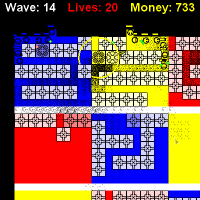 3 Players playing GauntNet | |
| Developer(s) | James Van Boxtel and Landon Kryger |
|---|---|
| Platform(s) | Java platform |
| Release | April 15, 2009 (Version 1.7) |
| Genre(s) | Tower defense |
| Mode(s) | Single-player, multiplayer |
GauntNet is a Java-based tower defense game created by Landon Kryger and James Van Boxtel in a game design class at Washington State University's Computer Science Program. [1] The game continues to gain popularity due to its multiplayer nature.
Contents
The game sets itself apart from other multiplayer tower defense games since up to eight players all play on the same board. In addition more than 40 different maps are playable making the maze and board size not fixed.